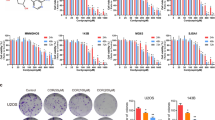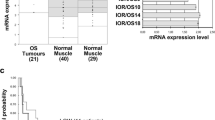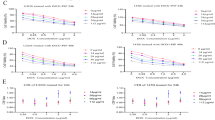Abstract
Purpose
Multidrug resistance (MDR) is a major obstacle to the successful treatment of osteosarcoma with chemotherapy. Effectiveness of cancer therapy correlates with the ability to induce a p53-dependent apoptotic response. p53 is a tumor suppressor gene that is mutated in 22 % of osteosarcomas. While impaired p53 has been implicated in the oncogenesis of osteosarcoma, it is unclear whether overexpression of wild-type p53 can increase chemosensitivity in MDR osteosarcoma cells.
Methods
We transfected a plasmid encoding the wild-type p53 gene to MDR osteosarcoma cell lines, which have different p53 statuses, U-2OSR2 with wild-type p53 (Wt-p53) and KHOSR2 with mutant p53 (Mt-p53), and determined the effect of p53 overexpression on chemosensitivities.
Results
Both of the U-2OSR2 and KHOSR2 cell lines displayed similar trends in p53-induced drug sensitivities. However, it seems that the impact of p53 overexpression is different based on the differential intrinsic p53 status in these cell lines. In the KHOSR2 cell line (Mt-p53), overexpression of p53 up-regulates the expression of pro-apoptotic protein p21 and Bax, while in the U-2OSR2 cell line (Wt-p53), overexpression of p53 down-regulates IGF-1r expression significantly.
Conclusions
These results demonstrated that transfection of wild-type p53 increases chemosensitivity either through inhibiting IGF-1r or through increasing the expression of pro-apoptotic proteins p21 and Bax in human MDR osteosarcoma cell lines.



Similar content being viewed by others
References
Chou AJ, Gorlick R (2006) Chemotherapy resistance in osteosarcoma: current challenges and future directions. Exp Rev Anticancer Ther 6(7):1075–1085. doi:10.1586/14737140.6.7.1075
Chou AJ, Merola PR, Wexler LH, Gorlick RG, Vyas YM, Healey JH, LaQuaglia MP, Huvos AG, Meyers PA (2005) Treatment of osteosarcoma at first recurrence after contemporary therapy: the Memorial Sloan-Kettering Cancer Center experience. Cancer 104(10):2214–2221. doi:10.1002/cncr.21417
Hawkins DS, Arndt CA (2003) Pattern of disease recurrence and prognostic factors in patients with osteosarcoma treated with contemporary chemotherapy. Cancer 98(11):2447–2456. doi:10.1002/cncr.11799
Kartner N, Riordan JR, Ling V (1983) Cell surface P-glycoprotein associated with multidrug resistance in mammalian cell lines. Science 221(4617):1285–1288
Perez-Tomas R (2006) Multidrug resistance: retrospect and prospects in anti-cancer drug treatment. Curr Med Chem 13(16):1859–1876
Ross DD (2000) Novel mechanisms of drug resistance in leukemia. Leukemia 14(3):467–473
Guo Y, Xu F, Lu T, Duan Z, Zhang Z (2012) Interleukin-6 signaling pathway in targeted therapy for cancer. Cancer Treat Rev 38(7):904–910. doi:10.1016/j.ctrv.2012.04.007
Susa M, Milane L, Amiji MM, Hornicek FJ, Duan Z (2011) Nanoparticles: a promising modality in the treatment of sarcomas. Pharm Res 28(2):260–272. doi:10.1007/s11095-010-0173-z
Duffy MJ, Synnott NC, McGowan PM, Crown J, O’Connor D, Gallagher WM (2014) p53 as a target for the treatment of cancer. Cancer Treat Rev 40(10):1153–1160. doi:10.1016/j.ctrv.2014.10.004
Ozaki T, Nakagawara A (2011) p53: the attractive tumor suppressor in the cancer research field. J Biomed Biotechnol 2011:603925. doi:10.1155/2011/603925
Feng Z, Zhang H, Levine AJ, Jin S (2005) The coordinate regulation of the p53 and mTOR pathways in cells. Proc Natl Acad Sci USA 102(23):8204–8209. doi:10.1073/pnas.0502857102
Selvarajah J, Nathawat K, Moumen A, Ashcroft M, Carroll VA (2013) Chemotherapy-mediated p53-dependent DNA damage response in clear cell renal cell carcinoma: role of the mTORC1/2 and hypoxia-inducible factor pathways. Cell Death Dis 4:e865. doi:10.1038/cddis.2013.395
Lourda M, Trougakos IP, Gonos ES (2007) Development of resistance to chemotherapeutic drugs in human osteosarcoma cell lines largely depends on up-regulation of clusterin/apolipoprotein. J Int J Cancer 120(3):611–622. doi:10.1002/ijc.22327
Duan Z, Choy E, Harmon D, Yang C, Ryu K, Schwab J, Mankin H, Hornicek FJ (2009) Insulin-like growth factor-I receptor tyrosine kinase inhibitor cyclolignan picropodophyllin inhibits proliferation and induces apoptosis in multidrug resistant osteosarcoma cell lines. Mol Cancer Ther 8(8):2122–2130. doi:10.1158/1535-7163.MCT-09-0115
Boyd SD, Tsai KY, Jacks T (2000) An intact HDM2 RING-finger domain is required for nuclear exclusion of p53. Nat Cell Biol 2(9):563–568. doi:10.1038/35023500
Castro ME, Leal JF, Lleonart ME, Ramon YCS, Carnero A (2008) Loss-of-function genetic screening identifies a cluster of ribosomal proteins regulating p53 function. Carcinogenesis 29(7):1343–1350. doi:10.1093/carcin/bgm302
Mossalam M, Matissek KJ, Okal A, Constance JE, Lim CS (2012) Direct induction of apoptosis using an optimal mitochondrially targeted p53. Mol Pharm 9(5):1449–1458. doi:10.1021/mp3000259
Han L, Zhao J, Liu J, Duan XL, Li LH, Wei XF, Wei Y, Liang XJ (2014) A universal gene carrier platform for treatment of human prostatic carcinoma by p53 transfection. Biomaterials 35(9):3110–3120. doi:10.1016/j.biomaterials.2013.12.048
Duan Z, Li X, Huang H, Yuan W, Zheng SL, Liu X, Zhang Z, Choy E, Harmon D, Mankin H, Hornicek F (2012) Synthesis and evaluation of (2-(4-methoxyphenyl)-4-quinolinyl)(2-piperidinyl)methanol (NSC23925) isomers to reverse multidrug resistance in cancer. J Med Chem 55(7):3113–3121. doi:10.1021/jm300117u
David-Pfeuty T, Chakrani F, Ory K, Nouvian-Dooghe Y (1996) Cell cycle-dependent regulation of nuclear p53 traffic occurs in one subclass of human tumor cells and in untransformed cells. Cell Growth Differ 7(9):1211–1225
Ganjavi H, Gee M, Narendran A, Parkinson N, Krishnamoorthy M, Freedman MH, Malkin D (2006) Adenovirus-mediated p53 gene therapy in osteosarcoma cell lines: sensitization to cisplatin and doxorubicin. Cancer Gene Ther 13(4):415–419. doi:10.1038/sj.cgt.7700909
Yusuf RZ, Duan Z, Lamendola DE, Penson RT, Seiden MV (2003) Paclitaxel resistance: molecular mechanisms and pharmacologic manipulation. Curr Cancer Drug Targets 3(1):1–19
Szakacs G, Paterson JK, Ludwig JA, Booth-Genthe C, Gottesman MM (2006) Targeting multidrug resistance in cancer. Nat Rev Drug Discov 5(3):219–234. doi:10.1038/nrd1984
Tognon CE, Sorensen PH (2012) Targeting the insulin-like growth factor 1 receptor (IGF1R) signaling pathway for cancer therapy. Exp Opin Ther Targets 16(1):33–48. doi:10.1517/14728222.2011.638626
Pan Y, Trojan J, Guo Y, Anthony DD (2013) Rescue of MHC-1 antigen processing machinery by down-regulation in expression of IGF-1 in human glioblastoma cells. PLoS ONE 8(3):e58428. doi:10.1371/journal.pone.0058428
Davison Z, de Blacquiere GE, Westley BR, May FE (2011) Insulin-like growth factor-dependent proliferation and survival of triple-negative breast cancer cells: implications for therapy. Neoplasia 13(6):504–515
Li R, Pourpak A, Morris SW (2009) Inhibition of the insulin-like growth factor-1 receptor (IGF1R) tyrosine kinase as a novel cancer therapy approach. J Med Chem 52(16):4981–5004. doi:10.1021/jm9002395
Baxter RC (2014) IGF binding proteins in cancer: mechanistic and clinical insights. Nat Rev Cancer 14(5):329–341. doi:10.1038/nrc3720
Pollak M (2008) Insulin and insulin-like growth factor signalling in neoplasia. Nat Rev Cancer 8(12):915–928. doi:10.1038/nrc2536
Ho L, Stojanovski A, Whetstone H, Wei QX, Mau E, Wunder JS, Alman B (2009) Gli2 and p53 cooperate to regulate IGFBP-3- mediated chondrocyte apoptosis in the progression from benign to malignant cartilage tumors. Cancer Cell 16(2):126–136. doi:10.1016/j.ccr.2009.05.013
Shen L, Dean NM, Glazer RI (1999) Induction of p53-dependent, insulin-like growth factor-binding protein-3-mediated apoptosis in glioblastoma multiforme cells by a protein kinase Calpha antisense oligonucleotide. Mol Pharmacol 55(2):396–402
Gimenez-Bonafe P, Tortosa A, Perez-Tomas R (2009) Overcoming drug resistance by enhancing apoptosis of tumor cells. Curr Cancer Drug Targets 9(3):320–340
Ketley NJ, Allen PD, Kelsey SM, Newland AC (2000) Mechanisms of resistance to apoptosis in human AML blasts: the role of differentiation-induced perturbations of cell-cycle checkpoints. Leukemia 14(4):620–628
Le Bras M, Rouy I, Brenner C (2006) The modulation of inter-organelle cross-talk to control apoptosis. Med Chem 2(1):1–12
Roos WP, Kaina B (2006) DNA damage-induced cell death by apoptosis. Trends Mol Med 12(9):440–450. doi:10.1016/j.molmed.2006.07.007
Galluzzi L, Senovilla L, Vitale I, Michels J, Martins I, Kepp O, Castedo M, Kroemer G (2012) Molecular mechanisms of cisplatin resistance. Oncogene 31(15):1869–1883. doi:10.1038/onc.2011.384
Wang D, Lippard SJ (2005) Cellular processing of platinum anticancer drugs. Nat Rev Drug Discov 4(4):307–320. doi:10.1038/nrd1691
Miao ZH, Tong LJ, Zhang JS, Han JX, Ding J (2004) Characterization of salvicine-resistant lung adenocarcinoma A549/SAL cell line. Int J Cancer 110(5):627–632. doi:10.1002/ijc.20026
Mayer F, Stoop H, Scheffer GL, Scheper R, Oosterhuis JW, Looijenga LH, Bokemeyer C (2003) Molecular determinants of treatment response in human germ cell tumors. Clin Cancer Res 9(2):767–773
Kim CW, Lu JN, Go SI, Jung JH, Yi SM, Jeong JH, Hah YS, Han MS, Park JW, Lee WS, Min YJ (2013) p53 restoration can overcome cisplatin resistance through inhibition of Akt as well as induction of Bax. Int J Oncol 43(5):1495–1502. doi:10.3892/ijo.2013.2070
Cho HJ, Kim JK, Kim KD, Yoon HK, Cho MY, Park YP, Jeon JH, Lee ES, Byun SS, Lim HM, Song EY, Lim JS, Yoon DY, Lee HG, Choe YK (2006) Upregulation of Bcl-2 is associated with cisplatin-resistance via inhibition of Bax translocation in human bladder cancer cells. Cancer Lett 237(1):56–66. doi:10.1016/j.canlet.2005.05.039
Sugimoto C, Fujieda S, Seki M, Sunaga H, Fan GK, Tsuzuki H, Borner C, Saito H, Matsukawa S (1999) Apoptosis-promoting gene (bax) transfer potentiates sensitivity of squamous cell carcinoma to cisplatin in vitro and in vivo. Int J Cancer 82(6):860–867
Gartel AL, Radhakrishnan SK (2005) Lost in transcription: p21 repression, mechanisms, and consequences. Cancer Res 65(10):3980–3985. doi:10.1158/0008-5472.CAN-04-3995
Mirzayans R, Andrais B, Scott A, Wang YW, Murray D (2013) Ionizing radiation-induced responses in human cells with differing TP53 status. Int J Mol Sci 14(11):22409–22435. doi:10.3390/ijms141122409
Liu S, Bishop WR, Liu M (2003) Differential effects of cell cycle regulatory protein p21(WAF1/Cip1) on apoptosis and sensitivity to cancer chemotherapy. Drug Res Updates 6(4):183–195
Waga S, Hannon GJ, Beach D, Stillman B (1994) The p21 inhibitor of cyclin-dependent kinases controls DNA replication by interaction with PCNA. Nature 369(6481):574–578. doi:10.1038/369574a0
Harper JW, Adami GR, Wei N, Keyomarsi K, Elledge SJ (1993) The p21 Cdk-interacting protein Cip1 is a potent inhibitor of G1 cyclin-dependent kinases. Cell 75(4):805–816
Niculescu AB 3rd, Chen X, Smeets M, Hengst L, Prives C, Reed SI (1998) Effects of p21(Cip1/Waf1) at both the G1/S and the G2/M cell cycle transitions: pRb is a critical determinant in blocking DNA replication and in preventing endoreduplication. Mol Cell Biol 18(1):629–643
Ogryzko VV, Wong P, Howard BH (1997) WAF1 retards S-phase progression primarily by inhibition of cyclin-dependent kinases. Mol Cell Biol 17(8):4877–4882
Lang GA, Iwakuma T, Suh YA, Liu G, Rao VA, Parant JM, Valentin-Vega YA, Terzian T, Caldwell LC, Strong LC, El-Naggar AK, Lozano G (2004) Gain of function of a p53 hot spot mutation in a mouse model of Li-Fraumeni syndrome. Cell 119(6):861–872. doi:10.1016/j.cell.2004.11.006
Olive KP, Tuveson DA, Ruhe ZC, Yin B, Willis NA, Bronson RT, Crowley D, Jacks T (2004) Mutant p53 gain of function in two mouse models of Li-Fraumeni syndrome. Cell 119(6):847–860. doi:10.1016/j.cell.2004.11.004
Linn SC, Honkoop AH, Hoekman K, van der Valk P, Pinedo HM, Giaccone G (1996) p53 and P-glycoprotein are often co-expressed and are associated with poor prognosis in breast cancer. Br J Cancer 74(1):63–68
Sampath J, Sun D, Kidd VJ, Grenet J, Gandhi A, Shapiro LH, Wang Q, Zambetti GP, Schuetz JD (2001) Mutant p53 cooperates with ETS and selectively up-regulates human MDR1 not MRP1. J Biol Chem 276(42):39359–39367. doi:10.1074/jbc.M103429200
Vasey PA, Jones NA, Jenkins S, Dive C, Brown R (1996) Cisplatin, camptothecin, and taxol sensitivities of cells with p53-associated multidrug resistance. Mol Pharmacol 50(6):1536–1540
Bossi G, Lapi E, Strano S, Rinaldo C, Blandino G, Sacchi A (2006) Mutant p53 gain of function: reduction of tumor malignancy of human cancer cell lines through abrogation of mutant p53 expression. Oncogene 25(2):304–309. doi:10.1038/sj.onc.1209026
Acknowledgements
This work was supported in part by grants from the Gattegno and Wechsler funds, the Stanton Foundation. Dr. Duan is supported, in part, through a grant from Sarcoma Foundation of America (SFA), a grant from National Cancer Institute (NCI)/National Institutes of Health (NIH), UO1, CA151452-01, a pilot grant from Sarcoma SPORE/NIH, and a grant from an Academic Enrichment Fund of MGH Orthopedic Surgery. The authors thank Yan Gao for assistance with densitometric analysis of Western blot results by Image J.
Author information
Authors and Affiliations
Corresponding author
Ethics declarations
Conflict of interest
The authors declare that they have no conflict of interest.
Rights and permissions
About this article
Cite this article
Ye, S., Shen, J., Choy, E. et al. p53 overexpression increases chemosensitivity in multidrug-resistant osteosarcoma cell lines. Cancer Chemother Pharmacol 77, 349–356 (2016). https://doi.org/10.1007/s00280-015-2944-z
Received:
Accepted:
Published:
Issue Date:
DOI: https://doi.org/10.1007/s00280-015-2944-z




